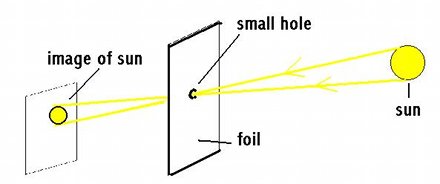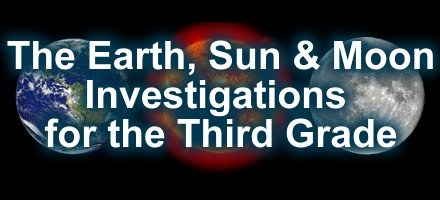
Summary

Introduction
The following is a set of suggested activities for a third grade curriculum unit on the Earth/Sun/Moon system. The goal is to provide students with an understanding of the motions of the three objects in the system and the way in which they determine the periodic changes we observe. In particular, students should develop an understanding of the way the Earth's daily rotation determines the cycle of light and dark that we call day and night; the way the Moon's motion about Earth determines the monthly cycle of lunar phases; and the way the Earth's orbital motion around the Sun determines the annual cycle of seasons. We also discuss how eclipses - solar as well as lunar - come about.
The cyclic changes we discuss are a visible and essential part of students' experience. In finding that they can systematically state, quantify, and model these changes, and that they can furthermore comprehend the astronomical phenomena that underlie them, students acquire not only a familiarity with scientific methods and facts but also a sense that these methods render the physical universe they inhabit essentially comprehensible. This in itself is an important aspect of teaching the unit, and we have attempted to structure the activities to make it explicit.
The activities are constructed to fulfill the requirements of the North Carolina Standard Course of Study objectives for third grade science. Included in these is an understanding of some aspects of the nature of Light. Several of the activities address this - they occur early in the Unit, as the facts about light are used extensively in the following Activities. As a study of light this is woefully incomplete; some related enrichment activities are included for teachers interested in taking this to slightly greater depth.
Understanding Material in 3-D
The understanding we aspire to make available to students involves thinking about the motions of the bodies in the system in three-dimensional space and can be quite challenging. The essential tool for making the abstract ideas comprehensible is the gradual construction of a model of the system which the students manipulate and observe in the classroom. In our model, a bright light bulb located in the center of the classroom will represent the Sun, a large (4" diameter) styrofoam ball the Earth, and a smaller (2" diameter) styrofoam ball the Moon. The classroom itself, with its walls, desks, and students, will become outer space, the dark vacuum in which these bodies exist; objects in the classroom, which remain fixed as we manipulate the "Earth" and "Moon" will be used to represent distant stars which appear fixed in space as the Earth and Moon move. The students themselves, inhabiting this region of space, will become "space giants," far larger than "Earth" and capable of surviving in space. The transition from the classroom as classroom to the classroom as space will be signalled by extinguishing the lights, and often by turning on the "Sun." While simplified and certainly not to scale, the model will capture most of the essential aspects of the phenomena we study. Manipulating concrete objects harnesses the student's intuition and observational skills. In fact, many of the complex concepts become "obvious."
The challenge, then, is to help the students translate phenomena as they are observed by the "space giants" to the experience of Earth-bound beings. This translation between the two different points of view will be gradually developed and is one of the important threads through the latter Activities.
Complexity of Material
Some of the concepts with which students are presented in this Unit are quite complex. It is unreasonable to expect that all students will grasp these at the same depth. Students emerging with an incomplete grasp of the concepts, however, will still benefit from the exposure. Studies show that many educated adults suffer from deep misconceptions about the nature of the phenomena we study, and many of these misconceptions are inculcated early. Encountering correct scientific explanations, as well as the scientific method of addressing questions, at a young age is an important antidote to these, and students will be more prepared to encounter the issues in higher grades (in North Carolina, much of this is reviewed in 6th grade).
The material in this unit and the teaching methods employed may be unfamiliar. DON'T PANIC. Teachers report that initially difficult concepts are far more clear to them in their second year with this curriculum, and the teaching methods second nature. Most of the learning in this unit will be through observation and active manipulation of models. We encourage you, the teacher, to help them collect their observations, generalize them, and ensure that the connections to the real-world phenomena are clear to all of them. This can be done through class discussion, questions and answers, demonstrations, etc. following the interactive Activity.
One important aspect of these notes is that we have made every effort to structure them so that students have an opportunity to observe in Nature as many of the phenomena under investigation as is possible. The challenge here is that some of these, like seasonal changes, can only be observed by making observations in different seasons - requiring that the teaching of this unit be distributed over essentially the entire school year. The activities described here are an attempt to combine the temporal requirements of observation with a sound pedagogical development of the material.
Extensions of Material
In teaching students these subjects it is natural that many questions will arise that are not addressed here, but would be natural extensions of the material included here. Examples of this are the nature and structure of the Sun and the Moon, their history and origin, the story of human exploration of space in general and the Moon in particular, etc. We have included some fragments of such information in the Teacher Background sections of the units but teachers should expect many relevant questions not answered here to come up. We plan to include an indexed database of some of these questions, together with the beginnings of answers, on this site. Please forward questions your students come up with to plesser@cgtp.duke.edu and we will try to respond by email, as well as collecting questions and answers for our database.
Observatory Trips
Finally, we have found that teaching this unit has been significantly enhanced by field trips to the Duke Observatory to observe some of the concepts in the sky. See http://www.cgtp.duke.edu/~plesser/observatory/ for details. If observatory visits are not practical, we strongly recommend an evening meeting for naked-eye observing to render abstract concepts concrete.

